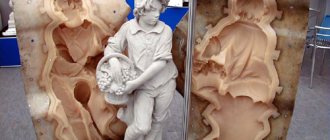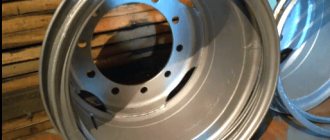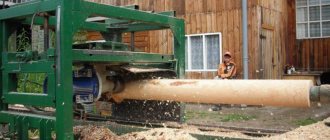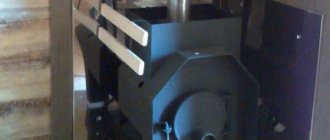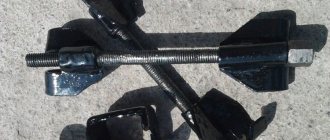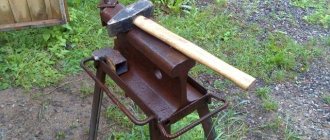The sinker is one of the consumable components of the tackle and often disappears along with the hook when biting large and strong prey. In stores, the cost of sinkers increases in direct proportion to their weight. Therefore, if catching large fish is carried out using several tackles, then purchasing sinkers becomes quite expensive.
At the same time, this element of equipment is quite simple to manufacture and practically does not require careful processing and complex preparation for use.
The material for the sinker is also quite common and accessible, so even complex sinkers can be made independently using appropriate blanks.
Simple options
The simplest thing is to make lead weights using a plaster or sand mold. This method has a number of undoubted advantages:
- accessibility and prevalence of material;
- lead melts at a relatively low temperature - 320°C;
- ease of manufacture.
The use of lead and gypsum when making sinkers yourself has several significant nuances:
- at a temperature of about 200°C, water begins to actively evaporate from gypsum , which leads to destruction of its structure and splitting of the product;
- Lead, when hardened, is pressed into plaster , which makes it almost impossible to remove the sinker without destroying the mold;
- a gypsum workpiece has a large number of micropores , which leads to the need to polish the finished product.
When using sand instead of gypsum, the process of preparing the mold is greatly simplified, however, the requirements for the material of the box in which the workpiece will be located when pouring lead are increased; it is advisable to use a metal support. The product itself will be somewhat less aesthetically pleasing and will require serious polishing.
DIY fishing sinkers
To ensure that the gear is cast a considerable distance from the shore, as well as to ensure its reliable immersion and fixation at the bottom of the reservoir, almost every fishing gear is equipped with a sinker. Despite the fact that in exceptional cases any metal object of suitable weight can be used for this purpose, a properly made sinker will allow you to catch fish as efficiently as possible.
What should the sinker be like?
A high-quality sinker must meet the following parameters:
- be heavy - for the manufacture of parts, as a rule, lead is used, which has the highest possible density from the materials available to the fisherman;
- have a streamlined shape with a perfectly smooth surface - when casting the tackle, aerodynamic forces act on the sinker. The rougher the surface of the sinker, the more rectangular its shape, the shorter the flight of the tackle will be when casting, and when retrieving fish or removing the tackle from the water for checking, more effort will be required;
- have a reliable fastening for the fishing line;
- do not stand out against the background of the bottom, so as not to scare away cautious fish;
- made from inexpensive materials.
Making simple disposable molds
The fragility and destruction of the gypsum structure when water evaporates makes it difficult to use this material for reusable use. However, as a disposable and easy-to-make mold, gypsum is ideal.
To make a shape for a simple sinker you need:
- Prepare a box for filling the mold; it should consist of two parts , tightly mounted on top of each other; you can use small boards fastened with screws;
- Dilute the gypsum to a creamy state , while trying to ensure that there are no air bubbles in the resulting mixture, since voids then appear in their place;
- The first layer of gypsum is poured into the lower part of the box , which should harden a little;
- The required sinker is immersed halfway into the plaster and, using a drill , on the side of the workpiece, a hole is made in the plaster for pouring lead (it is better to insert cylinders of suitable size into these holes);
- The surface of the frozen layer is greased with vegetable oil so that the halves of the mold can then be easily separated;
- The second part of the box is installed on top , into which gypsum is poured;
- After the entire structure has hardened, the box is disassembled , both parts of the mold are separated and the sinker and cylinders of the filling channels are removed;
- The mold is cleaned and covered from the inside with a layer of soot using soot from a burning candle;
- The ears and loops for the sinker are attached , the mold is assembled and secured with wire;
- The finished form should dry well ; to do this, you need to place it in a dry place for 1-2 days or use the oven.
The easiest way to make a cone-shaped sinker is to use a paper cone in the sand:
- A paper blank (a piece of paper rolled into a cone) is inserted into any container tightly filled with sand; a metal loop for a sinker is inserted into the sharp end of the cone;
- Lead is melted and poured into a paper cone;
- Part of the cone burns, but during this time the lead has time to cool a little and begin to harden;
- The cooled workpiece is removed from the sand and processed with a file.
You can use aluminum foil instead of paper.
The material for the sinker is also quite common and accessible, so even complex sinkers can be made independently using appropriate blanks
Where can I get lead?
Do-it-yourself fishing sinkers are poured from any lead that you have on hand. The easiest way to obtain lead is to go to a tire shop and buy used balance weights. Such lead will cost much less than if you buy sheet lead. You can buy the required number of kilograms and get a large number of weights from them for various purposes. The only thing to consider is the steel pieces molded into the middle of some of the weights. It is advisable to remove them during melting. But you usually don’t come across many such sinkers. The weights can be melted all together without sorting them by density.
The second way to extract lead is from old batteries. It is better to find points where they accept old batteries and buy them at a reasonable price. This is a more complicated method, since you will have to disassemble the batteries to remove the lead.
The third way to get lead out of cable braids. It is made of sheet lead with a thickness of 1, 1.5 and 2 mm. If you know any electricians, ask if they can get this braid. From such lead you can not only cast weights, but also cut strips for feeder feeders.
The most expensive way is to buy lead. It is sold in sheets and ingots. Better, of course, is sheet metal, but its size is very large. In such cases, fishermen unite and buy one sheet together.
You can also make weights with your own hands from old weights, which almost every angler probably has.
One thing is certain: absolutely any lead is suitable for casting sinkers with your own hands. It doesn't matter if it has impurities, or how dense or soft it is. Our task is weights for bottom fishing.
Forms for regular use
A plaster mold, even a very well made and dried one, will sooner or later collapse and you will have to make a new one or use a product suitable for frequent use.
Of course, for repeated use, molds made of heat-resistant steel or cast iron are best suited, but making these yourself is almost impossible. But cement is good for creating a melting mold, although this will require a little work.
Materials and tools for reusable uniforms:
- formwork material (wooden boards);
- liquid soap;
- cement;
- round file;
- fine sandpaper;
- clamp;
- cylinders for inserting into the filler hole;
- wire for making loops for the sinker.
For repeated use, molds made of heat-resistant steel or cast iron are best suited, but making these yourself is almost impossible
How to make sinkers at home? (Mark Roberts)
Making fishing sinkers at home is not only a very simple task, but also very profitable. Considering the cost of branded items, compared to a large number of force majeure situations when fishing, you will save a good amount of money. Not to mention the specific features of “extreme” types of carp fishing (for example, in snags or algae), which always involve “losing” the sinkers.
But you will still have to fork out a little, for example, to purchase casting molds and plastic powder for a special coating of ready-made sinkers (which can be easily found on the shelves of fishing stores). But, believe me, these investments will bring you solid dividends in the future.
Making a reusable cement mold
Creating a cement mold is quite time-consuming, this is due to the relatively long hardening of the mixture.
The process of creating the form itself looks something like this:
- Formwork is made , preferably collapsible;
- The inner surface of the formwork is covered with liquid soap and installed on a flat surface, also treated with a soap solution;
- The formwork is filled with cement mortar;
- in the not yet hardened cement ;
- The cement must harden completely , this may take 1-2 days;
- After the cement has completely dried , the formwork is disassembled and reassembled for the next filling;
- The first, frozen half , together with the protruding workpiece, is smeared with soap;
- The second half of the mold is prepared , cement is poured into it;
- The first half , with its surface covered with soapy water, is placed on the second part of the mold;
- The cement hardens again;
- After the cement has dried in both halves of the mold , the central cone-shaped holes in each half are bored with a round needle file for pouring lead, and two side channels are also made for air removal;
- The surface of the sinker mold is sanded;
- Before pouring, the mold halves are tightly held together with a clamp.
Content
- Materials
- Samples
- Mold making
- Casting sinkers
- Pros and cons of making your own sinkers
Hi all! Today I want to share my ideas, best practices and experience in making lead weights for spinning fishing.
I’ll say right away: this method is only suitable for small batches and simple shapes of sinkers. For example, I would recommend making collapsible Cheburashkas using aluminum molds, which I use myself)
Before the start of the season, I decided to add weights to my collection - “bullets”, for the increasingly popular jig-rig.
Blitz tips
- The porosity of a plaster mold and the tendency of lead to stick when curing can be greatly reduced by using chalk or talc on the inside of the mold to fill voids and create a layer between the lead and the plaster.
- To increase the service life of a plaster mold, you can impregnate and treat it from the inside with a sealant to reduce water evaporation when pouring metal. It won't be durable, but it will probably last a few more uses.
- When making small sinkers, regular matches or nails can be used to create outlet channels by simply sticking them into the mold material before it hardens.
- Instead of soap solution and vegetable oil, you can use silicone grease.
Final processing
After the casting process is completed, the finished products will need to be processed. If the load is made in a spoon, then to fasten the scaffolding you need to drill a hole in the metal body. It is done in the narrowed part with a drill with a 2 mm drill bit. Just be sure to remove the chamfer with a drill so that the fishing line does not tear on a sharp metal edge in the future.
To ensure that the weights are not particularly noticeable in water, they should be treated with an aqueous solution of potassium permanganate. Immerse the parts in it for several hours. The sinkers also need to be sanded using emery or a velvety file.
This is what homemade weights look like after processing.
When working with lead, do not forget about safety precautions. It is unacceptable to cast sinkers in a closed room, so as not to inhale toxic fumes.
Also, it is unacceptable to use utensils for cooking.
Donkey installation
A spinning rod is a sensitive and reliable tackle, but to ensure this sensitivity you need to use a sliding sinker. The advantages of this installation are that when a fish takes the bait, it does not feel the weight of the load and is not frightened, as is the case with a bait donkey. This is especially true for trophy fish, which are very careful and attentive to unfamiliar objects.
On the one hand, she is attracted by the smell, color and taste of the nozzle, but, on the other hand, she needs to remain careful and attentive. A sliding sinker allows the fish to swallow the bait without fear and pull it to the side, and at this moment the movement of the sinker along the line stops and a hook occurs
At the same time, the load itself must be flat so as not to move along the bottom under the pressure of the current and the pulls of the fish.
To install a spinning rod you will need:
- a piece of fishing line 40 cm long, 0.25 mm in diameter;
- sliding sinker;
- triple swivel;
- float stops;
- two leashes 15 cm long, with hooks made of monofilament fishing line with a diameter of 0.2 mm.
Installation procedure:
- make a loop from one end of the fishing line for tying to the base;
- pull the float stopper onto the fishing line and guide it to the loop;
- pull the sinker along the fishing line;
- put on another float stopper;
- tie a triple swivel to the free end of the fishing line using the upper ring;
- lower the lower stopper to the swivel;
- tie leashes to the free rings of the swivel.
Installation is simple, but catchy, and for different fish. When fishing for crucian carp or bream, leashes are made from monofilament fishing line. If the catch is expected to include carp or catfish, the leashes are knitted from soft braid and their length is shortened to 5–7 cm. Short leashes are less tangled and do not create problems for the angler when fishing and casting.
The stoppers limit the movement of the weight along the line, and the lower stopper prevents the weight from hitting the swivel assembly during power casts. If the hook gets caught on a snag or grass, only the leash tied on a thin fishing line comes off, and the rest of the equipment remains intact. To restore the tackle, you only need to tie a new leash or leashes.
Which ones are needed for a fishing rod?
To answer this question, you need to decide on the type of catch you expect and what kind of fishing rods you will use.
For float
This type of fishing does not require a lot of weight. You just need to immerse the fishing line to the desired depth in relatively calm water. This task is accomplished by one or more pellets attached to a fishing line.
Expert opinion
Knipovich Nikolai Mikhailovich
Zoologist, hydrobiologist. I am interested in fishing at a professional level.
Experienced fishermen advise attaching several pellets by cutting them and inserting the fishing line into the cut. In this case, the smallest one should be closer to the hook. The distance between the pellets should be from 5 to 7 cm.
There is no consensus on what the size of a single pellet should be. Typically, balls with a diameter of 3 to 7 mm are placed.
For spinning
The presence of a sinker is not necessary for this fishing method. If the bait is heavy, casting is carried out without it. If the weight of the bait is small, more advanced products are required. Shape and weight become categorically important, since casting distance depends on them.
- Spoon-shaped weight. You can easily make it yourself by pouring molten lead into a hole in the ground.
- Rhombus. Such products are produced in factories. The average weight of a lead diamond is 30 g, although some specimens reach up to 75 g. They are designed for casting at an average distance.
- Ball. A mathematically ideal shape is not ideal for fishing. Such sinkers are not recommended for use on fast rivers, since the current can roll them along the bottom.
- Spindle-shaped weights. Good for long casts.
For the donkey
Expert opinion
Knipovich Nikolai Mikhailovich
Zoologist, hydrobiologist. I am interested in fishing at a professional level.
For this kind of donk fishing, weights are cast from gart or lead.
There are several nuances:
- For fishing on a flat coastal area, you need a heavy weight.
- If you plan to fish on a pond, lake or calm river, you need to take a sinker that is not too heavy.
- For fishing on muddy or rocky bottoms, it is better to use a round, conical or pear-shaped weight.
- On a sandy bottom and in strong currents, a flat sinker will help out.
- If there is a lot of debris at the bottom, choose a weighting agent like a vanka-stand. It has a floating top, and the weight occupies a vertical position, supporting the hooks with bait above the bottom.
Safety precautions
When casting sinkers over an open fire, fire safety requirements must be observed. Keep water nearby to extinguish potential fires. NEVER pour it into a container with lead.
The room should be well ventilated, ideally have a hood. The melting process should not be left unattended, but you need to choose thick clothing. Long sleeves and gloves are required to protect your hands from burns if lead is splashed.
Make sure that there are no flammable substances or flammable objects near the stove, fire or electric crucible. This especially applies to clothing. In addition, it is very difficult to remove the chemical smell of lead from it.
For bottom gear
Fishing through a donk is the most popular method due to the ease of making gear (you can do it yourself) and the efficiency of the catch.
Loads are:
- round and oval (“spoons”) - optimal for reservoirs without current;
- triangular and trapezoidal;
- rectangular and diamond-shaped (suitable for casting in currents);
- camouflage painted to match the surface color;
- three-blade with good aerodynamics;
- remote for long casts;
- with a swivel for unhindered sliding of the sinker;
- studded for better grip on the bottom.
In order not to delve into all these types, it is better for beginners to focus on the convenience of the gear. Experienced fishermen recommend tying a sinker to a fishing line on a drop-shaped bottom with an eye and a weight of 0.03-0.1 kg. Due to the streamlining, you can cast the bait far and silently. When the current is strong, use a heavy weight; when the current is weak, a light weight is enough - weighing 30 grams or more. If the bottom is muddy, the shape should be flat so that it does not sink and pull the leash along with it.
Sinker for a bottom fishing rod - what it should be
Before looking for an answer to the question of how to tie a sinker to a donka fishing rod, a fisherman must study the varieties of this fishing tackle.
When buying a bottom sinker in a store, pay attention to the following parameters:
- Product form. The most famous and popular options among buyers are sinkers in the form of an olive, a drop or a pellet.
- Donk mounting method. Usually the load is fixed on the fishing line in such a way that it either slides along it or remains motionless.
- The materials from which the element is created, their quality characteristics. On sale you can find sinkers made of metal alloys (including lead or tungsten). The first option has a significant drawback - a high level of toxicity. In England, for example, lead weights for fishing rods are generally prohibited because they are considered hazardous to health.
- Sinker weight. The product can have a mass of 3-75 g. (this parameter depends on its shape).
Drop-shaped weights are in great demand among fishermen. They are easily retrieved from the bottom of the reservoir and fly well. However, loads of this shape have some disadvantages. For example, they do not hold the float well in large currents. If you plan to fish in choppy waters, choose a flat sinker. It is not so pliable to a strong current and helps the hook sink to the very bottom. But it is worth considering that in this case the fishing line more often gets stuck between the stones at the bottom of the reservoir and breaks.
The weight of the sinker is selected based on the characteristics of the reservoir:
- if the river has a flat bank, then it is better to equip the bottom with a more powerful load (to cast the line as far as possible);
- to fish in reservoirs with stagnant water, it is better to equip the rod with a sinker with a small weight;
- round, pear-shaped or conical weights are suitable for fishing in rivers and lakes with a rocky, silty bottom;
- flat sinker models are an ideal choice for reservoirs with a sandy bottom and large currents;
- a sinker, which has a floating upper part, is useful for fishing in rivers where the bottom is strewn with a lot of debris.
When choosing a weight for a donkey, look at its quality and do not buy a homemade product. It is very easy to distinguish a product created in a handicraft way from one made in an industrial environment. In the first case, the cargo has an untidy appearance, an uneven surface and a too soft structure. In addition, its actual weight is always very different from that stated by the seller. Of course, an experienced fisherman will be able to fish with such a sinker on the line, but for a beginner this activity will be too difficult.
When choosing a sinker for the bottom, pay attention to how smooth its surface is. Smooth weights have minimal resistance when in the water at the moment of biting
To increase this parameter, some sinker manufacturers even coat their surface with varnish.
Pour out the cone weights
Donkers and spinning fishermen often use hand-made conical weights. The former are used because they fly far and accurately, while spinners use them in spaced rigs. Making these weights yourself is very easy. You don't even need forms. We will need hard paper, with which we will make cones in the form of small bags.
We also need thin and stiff wire. From it we will make eyelets through which the weights will be attached to the main fishing line.
We will pour the sinkers with our own hands in exactly the same way as last time. Instead of a gas burner, you can use a portable one with two burners. It will be possible to pour in two containers to make the process faster. In this case, place the jars on the stove at intervals of 5 minutes. The lead has melted in one, pour it straight into the molds. After this operation, the lead should melt in the second container.
We insert wire staples into the paper molds so that the eye sticks out from the top of the cone. We immerse the molds in the ground so that they take a vertical position. We select the size of the molds experimentally. We estimate by eye what kind of weight we need. As a standard, you can take a 35 gram weight and look at it. It will be enough to pour out the first batch of sinkers for fishing with your own hands. We will use the resulting weights as samples when we make molds for the next batches.
The pouring process is identical to the previous one. You can use an unnecessary metal mug as a container for lead. It is convenient to take it by the handle and pour lead from it. To avoid burning your fingers, it is better to wear gloves on your palms. After pouring, you should wait a little and remove the weights from the molds. We just tear off the paper without sparing, since initially the molds are disposable.

